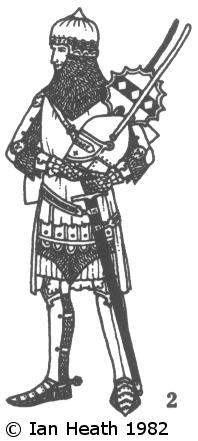
Create an Amazon Wedding Registry
SIR JOHN DE CREKE 1330
An extract from Armies of the Middle Ages, Volume 1by Ian Heath


2. SIR JOHN DE CREKE 1330
Based on the brass of de Creke at Westley Waterless, one of the more immediately noticeable differences between this figure and the last is the much-shortened surcoat, of a type today usually called a cyclas, popular in the late-1320s and 1330s. In fact a large number of modern authorities have actually divided up the mediaeval era according to the style of surcoat worn at the time; thus Ashdown broke our era down into the cyclas period (1325-1335), the jupon period (1360-1410), the surcoatless period (1410-1430) and the tabard period (1430-1500). He describes the cyclas as laced at the sides and knee-length behind but cut short at the front. Being cut short in front in fact enables us to see the several layers of armour that were now, and for most of the 14th century, worn on the body, comprising gambeson, mail hauberk, coat-of-plates and surcoat, the latter itself often quilted (see notes 7 and 33). By the mid-14th century these defences were further strengthened by a layer of plate armour (see note 6), but Jean le Bel (who wrote c. 1352-56) remarks of the period around 1330 that the English then wore no plate armour, nor bascinets with visors, though the helmet worn by figure 1, from the English Holkham Picture Bible of c. 1320, would seem to indicate otherwise.
The helm Sir John holds here, taken from the Luttrell Psalter of c. 1335-40, similarly boasts a movable visor. Helms of this sort, generally round-topped as here or of ‘sugar-loaf’ design, continued to be worn in battle until the early years of the 15th century, particularly in Italy and Germany, but after the mid-14th century they were usually reserved for tournament use. A great many had no perforations at all in the visor or lower mask, while others (such as the Black Prince’s helm in Canterbury Cathedral) had perforations on the right side only, leaving the left plain so as to present a smooth glancing surface to an enemy’s lance. The cruciform hole on the lower left of Luttrell’s helmet was for inserting the chain that was often used to attach the helm to the belt or, later, the breastplate. As can be seen here, by this date the helm was usually worn over a bascinet, to which by c. 1330 the mail aventail or camail was fixed by passing a cord or wire through staples called vervelles round the rim of the helmet. Later the camail was often tied down to the body armour as well, to prevent lance or sword thrusts from passing beneath it.
The appearance of a crest on Luttrell’s helm brings us to the seldom-broached question of whether or not such crests were actually worn in battle. Barbour records the Scots seeing crested helmets for the first time during Edward III’s expedition of 1327, so they were certainly still being worn then. Interestingly the very next year King Philip VI wore a fleur-de-lis crested helm en route to Cassel, but changed to a leather-covered bascinet for the actual battle. It certainly seems that crests had generally ceased to be worn in battle by the outbreak of war in 1337 (but see note 75), and Froissart confirms this: he says that until that time (1337) one spoke of men-at-arms as ‘crested helms’, but that thereafter they were usually spoken of simply as ‘bascinets’ or ‘lances’. Jean le Bel too remarks on ‘crested helms which used to be worn’, comparing them with the plain iron helmets worn in his own day. Thereafter the crest was chiefly relegated to the tournament.
With the exception of his scale armour gauntlets Sir John’s equipment is otherwise unremarkable. On the brass his hands are in fact shown bare, the gauntlets depicted here being taken from an alternative source of c. 1310. Scale was still to be found in occasional use throughout the 14th century and into the early-15th, usually (but not exclusively) for small portions of armour such as gloves, sleeves, gorget and sabatons. The brass of Sir John de Northwode, for instance, shows scale sleeves on the forearms (c. 1337), and that of William de Cheyne shows scale sabatons (1375). The scales seem to have been most commonly of leather, baleen, iron or latten (or latoun, a bronze and tin alloy resembling brass).
Note the appearance of rowel spurs, which had generally replaced the prick spur by c. 1330. The number of points on the rowel usually varied between 6 and 12, though some looked rather like cog-wheels, with up to 20 or more points.